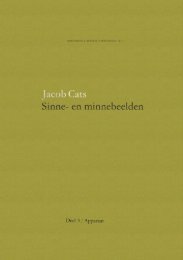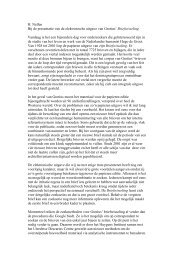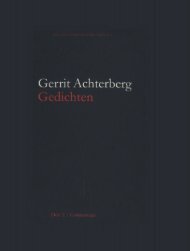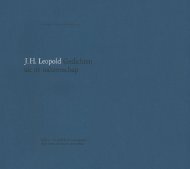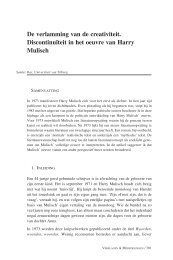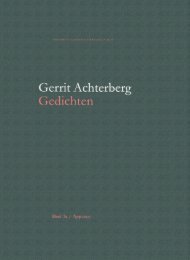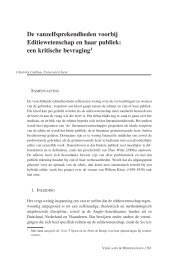- Page 1 and 2:
Middeleeuwse Verzamelhandschriften
- Page 3 and 4:
Afb. 1 Wiesbaden, Hessisches Haupts
- Page 5 and 6:
Middeleeuwse Verzamelhandschriften
- Page 7 and 8:
6 Het Wiesbadense handschrift Veran
- Page 9 and 10:
8 Het Wiesbadense handschrift hands
- Page 12 and 13:
Inleiding Geschiedenis van het onde
- Page 14 and 15:
Inleiding 13 een gemeenschap van de
- Page 16 and 17:
Inleiding 15 3. Tweede deel (f. 90-
- Page 18 and 19:
Inleiding 17 verbonden met de onder
- Page 20 and 21:
Inleiding 19 karakter heeft. In het
- Page 22 and 23:
Inleiding 21 7. Besluit In het bove
- Page 24 and 25:
Inleiding 23 de versozijde van f. 1
- Page 26 and 27:
Inleiding 25 ternen vormen een eenh
- Page 28 and 29:
Inleiding 27 Tabel 1. Verdeling van
- Page 30 and 31:
Inleiding 29 verdeling willen sugge
- Page 32 and 33:
Inleiding 31 Afb. 2 f. 3r (detail).
- Page 34 and 35:
Inleiding 33 3’, 47 en de z (met
- Page 36 and 37:
Inleiding 35 hand 7 voor een r noga
- Page 38 and 39:
Inleiding 37 Afb. 6 f. 62r (detail)
- Page 40 and 41:
Inleiding 39 Afb. 10 f. 97r (detail
- Page 42 and 43:
Inleiding 41 Eenheid IIb Deze eenhe
- Page 44 and 45:
Inleiding 43 (tekst 35), waarna een
- Page 46 and 47:
Inleiding 45 gebleven ruimte boven
- Page 48 and 49:
Inleiding 47 Afb. 13 f. 110r (detai
- Page 50 and 51:
Inleiding 49 kens zijn meestal schu
- Page 52 and 53:
Inleiding 51 lijkt erg veel op dat
- Page 54 and 55:
Inleiding 53 Tabel 3. Overzicht van
- Page 56 and 57:
Inleiding 55 Afb. 17 f. 45r (detail
- Page 58 and 59:
Inleiding 57 Afb. 24 f. 25r (detail
- Page 60 and 61:
Inleiding 59 bara, die op f. 118v g
- Page 62 and 63:
Inleiding 61 de tekeningen geplakt
- Page 64 and 65:
Inleiding 63 sneden banderol met, e
- Page 66 and 67:
Inleiding 65 Salvator Mundi gelijmd
- Page 68 and 69:
Inleiding 67 de drie gebeden (tekst
- Page 70 and 71:
Inleiding 69 geleding zijn rode lom
- Page 72 and 73:
Inleiding 71 langs de contouren ext
- Page 74 and 75:
Inleiding 73 ook voor elk van de vi
- Page 76 and 77:
Inleiding 75 Afb. 30 f. 13v-14r
- Page 78 and 79:
Inleiding 77 F. 152 en 25 Folium 15
- Page 80 and 81:
Inleiding 79 de oostelijker. De opp
- Page 82 and 83:
Inleiding 81 sel gelokaliseerd word
- Page 84 and 85:
Inleiding 83 gesprokener Kustwestvl
- Page 86 and 87:
Inleiding 85 ven te extreem om de t
- Page 88 and 89:
Inleiding 87 fragiele zilverstiftfi
- Page 90 and 91:
Inleiding 89 ning en het afgewerkte
- Page 92 and 93:
Inleiding 91 vraag is natuurlijk of
- Page 94 and 95:
Inleiding 93 Tabel 4. Overzicht van
- Page 96 and 97:
Inleiding 95 De basis van de compos
- Page 98 and 99:
Inleiding 97 ning van de doop van C
- Page 100 and 101:
Inleiding 99 passing van de tekenin
- Page 102 and 103:
Inleiding 101 Inc.: Om dat god alle
- Page 104 and 105:
Inleiding 103 zie Hogenelst, 1997,
- Page 106 and 107:
Inleiding 105 30 f. 91va-30: Armoed
- Page 108 and 109:
Inleiding 107 43 f. 116vb32-39: Spr
- Page 110 and 111:
Inleiding 109 59 f. 135rb4-135vb: O
- Page 112 and 113:
Inleiding 111 75 f. 147ra-151rb13:
- Page 114 and 115:
Afkortingen 113 [6] 108rb 3me (omme
- Page 116 and 117:
Afkortingen 115 [3] *he’n (heren)
- Page 118 and 119:
Afkortingen 117 b. bij contractie:
- Page 120 and 121:
Afkortingen 119 [2 3 4] Ø [5] 105v
- Page 122 and 123:
Afkortingen 121 b. afkorting voor
- Page 124 and 125:
Afkortingen 123 (b) ‘anderen’ D
- Page 126 and 127:
Afkortingen 125 waracht.../waeracht
- Page 128 and 129:
Verantwoording van de editie Editie
- Page 130 and 131:
Verantwoording van de editie 129 2.
- Page 132 and 133:
Verantwoording van de editie 131 5.
- Page 134 and 135:
Verantwoording van de editie 133 De
- Page 136 and 137:
Editie
- Page 138 and 139:
1 Wech van salicheit, inhoudsopgave
- Page 140 and 141:
1 Wech van salicheit, inhoudsopgave
- Page 142 and 143:
1 2 3 | 4 Inhoudsopgave codex (2) 1
- Page 144 and 145:
1 4 8 12 16 20 24 28 5 Wech van sal
- Page 146 and 147:
68 72 76 80 84 88 92 96 100 104 5 W
- Page 148 and 149:
148 152 156 160 164 168 172 176 180
- Page 150 and 151:
224 228 232 236 240 244 248 252 5 W
- Page 152 and 153:
288 292 296 300 304 308 312 316 320
- Page 154 and 155:
360 364 368 372 376 380 384 388 392
- Page 156 and 157:
432 436 440 444 448 452 456 460 464
- Page 158 and 159:
496 500 504 508 512 516 520 524 528
- Page 160 and 161:
568 572 576 580 584 588 592 596 600
- Page 162 and 163:
632 636 640 644 648 652 656 660 5 W
- Page 164 and 165:
700 704 708 712 716 720 724 728 5 W
- Page 166 and 167:
760 764 768 772 776 780 784 788 5 W
- Page 168 and 169:
828 832 836 840 844 848 852 856 860
- Page 170 and 171:
896 900 904 908 912 916 920 924 5 W
- Page 172 and 173:
964 968 972 976 980 984 988 992 996
- Page 174 and 175:
1036 1040 1044 1048 1052 1056 1060
- Page 176 and 177:
1108 1112 1116 1120 1124 1128 1132
- Page 178 and 179:
1180 1184 1188 1192 1196 1200 1204
- Page 180 and 181:
1256 1260 1264 1268 1272 1276 1280
- Page 182 and 183:
1324 1328 1332 1336 1340 1344 5 | I
- Page 184 and 185:
Ingevoegde bladen 183 /15v/ /sameng
- Page 186 and 187:
folio 14r, afb. 33 185
- Page 188 and 189:
folio 15r, afb. 35 187
- Page 190 and 191:
folio 16r, afb. 37 189
- Page 192 and 193:
1368 1372 1376 1380 1384 1388 1392
- Page 194 and 195:
1440 1444 1448 1452 1456 1460 1464
- Page 196 and 197:
1504 1508 1512 1516 1520 1524 1528
- Page 198 and 199:
1572 1576 1580 1584 1588 1592 1596
- Page 200 and 201:
1648 1652 1656 1660 1664 1668 1672
- Page 202 and 203:
1716 1720 1724 1728 1732 1736 1740
- Page 204 and 205:
1780 1784 1788 1792 1796 1800 1804
- Page 206 and 207:
1848 1852 1856 1860 1864 1868 1872
- Page 208 and 209:
1924 1928 1932 1936 1940 1944 1948
- Page 210 and 211:
1996 2000 2004 2008 2012 2016 2020
- Page 212 and 213:
2064 2068 2072 2076 2080 2084 2088
- Page 214 and 215:
2132 2136 2140 2144 2148 2152 2156
- Page 216 and 217:
5 | Ingevoegde bladen 215 /24v/ /vi
- Page 218 and 219:
folio 24r, afb. 39 217
- Page 220 and 221:
folio 25r, afb. 41 219
- Page 222 and 223:
2192 2196 2200 2204 2208 2212 2216
- Page 224 and 225:
2260 2264 2268 2272 2276 2280 2284
- Page 226 and 227:
2328 2332 2336 2340 2344 2348 2352
- Page 228 and 229:
2400 2404 2408 2412 2416 2420 2424
- Page 230 and 231:
2468 2472 2476 2480 2484 2488 2492
- Page 232 and 233:
2540 2544 2548 2552 2556 2560 2564
- Page 234 and 235:
2608 2612 2616 2620 2624 2628 2632
- Page 236 and 237:
2684 2688 2692 2696 2700 2704 2708
- Page 238 and 239:
2748 2752 2756 2760 2764 2768 2772
- Page 240 and 241:
2816 2820 2824 2828 2832 2836 2840
- Page 242 and 243:
2884 2888 2892 2896 2900 2904 2908
- Page 244 and 245:
2948 2952 2956 2960 2964 2968 2972
- Page 246 and 247:
3024 3028 3032 3036 3040 3044 3048
- Page 248 and 249:
3096 3100 3104 3108 3112 3116 3120
- Page 250 and 251:
3168 3172 3176 3180 3184 3188 3192
- Page 252 and 253:
3236 3240 3244 3248 3252 3256 3260
- Page 254 and 255:
3312 3316 3320 3324 3328 3332 3336
- Page 256 and 257:
3384 3388 3392 3396 3400 3404 3408
- Page 258 and 259:
3456 3460 3464 3468 3472 3476 3480
- Page 260 and 261:
3528 3532 3536 3540 3544 3548 3552
- Page 262 and 263:
3600 3604 3608 3612 3616 3620 3624
- Page 264 and 265:
3672 3676 3680 3684 3688 3692 3696
- Page 266 and 267:
3744 3748 3752 3756 3760 3764 3768
- Page 268 and 269:
3816 3820 3824 3828 3832 3836 3840
- Page 270 and 271:
3888 3892 3896 3900 3904 3908 3912
- Page 272 and 273:
3956 3960 3964 3968 3972 3976 3980
- Page 274 and 275:
4032 4036 4040 4044 4048 4052 4056
- Page 276 and 277:
4100 4104 4108 4112 4116 4120 4124
- Page 278 and 279:
4172 4176 4180 4184 4188 4192 4196
- Page 280 and 281:
4248 4252 4256 4260 4264 4268 4272
- Page 282 and 283:
4320 4324 4328 4332 4336 4340 4344
- Page 284 and 285:
4388 4392 4396 4400 4404 4408 4412
- Page 286 and 287:
4464 4468 4472 4476 4480 4484 4488
- Page 288 and 289:
4536 4540 4544 4548 4552 4556 4560
- Page 290 and 291:
folio 45r, afb. 43 289
- Page 292 and 293:
1 4 8 7 Jean Gerson, Miroir de l’
- Page 294 and 295:
48 52 56 60 64 68 72 76 80 84 7 Jea
- Page 296 and 297:
120 124 128 132 136 140 144 148 152
- Page 298 and 299:
196 200 204 208 212 216 220 224 7 J
- Page 300 and 301:
268 272 276 280 284 288 292 296 300
- Page 302 and 303:
344 348 352 356 360 364 368 372 376
- Page 304 and 305:
420 424 428 432 436 440 444 448 452
- Page 306 and 307:
492 496 500 504 508 512 516 520 524
- Page 308 and 309:
564 568 572 576 580 584 588 592 596
- Page 310 and 311:
640 644 648 652 656 660 664 668 672
- Page 312 and 313:
720 724 728 732 736 740 744 1 7 | 8
- Page 314 and 315:
36 40 44 48 1 4 8 12 9 | 10 Gebed 3
- Page 316 and 317:
56 60 64 68 72 76 80 1 4 8 10 | 11
- Page 318 and 319:
12 16 20 24 28 32 36 40 11 | 12 Aug
- Page 320 and 321:
84 88 92 96 100 104 108 112 116 12
- Page 322 and 323:
156 160 164 168 172 176 180 184 188
- Page 324 and 325:
236 240 244 248 252 256 260 264 268
- Page 326 and 327:
312 316 320 324 328 332 336 340 344
- Page 328 and 329:
384 388 392 396 400 404 408 412 416
- Page 330 and 331:
456 460 464 468 472 476 480 484 488
- Page 332 and 333:
532 536 540 544 548 552 556 560 564
- Page 334 and 335:
600 604 608 612 616 620 624 628 12
- Page 336 and 337:
664 668 672 676 680 684 688 692 696
- Page 338 and 339:
736 740 744 748 752 756 760 764 768
- Page 340 and 341:
812 816 820 824 828 832 836 840 12
- Page 342 and 343:
880 884 888 892 896 900 904 908 12
- Page 344 and 345:
948 952 956 960 964 968 972 976 12
- Page 346 and 347:
1016 1020 1024 1028 1032 1036 1040
- Page 348 and 349:
1 4 8 12 16 20 24 13 14 15 16 | 17
- Page 350 and 351:
64 68 72 76 80 84 88 92 96 100 104
- Page 352 and 353:
144 148 152 156 160 1 4 8 17 | 18 S
- Page 354 and 355:
20 1 4 8 12 16 20 24 28 32 19 20 21
- Page 356 and 357:
4 8 12 1 4 8 22 23 24 25 | Ingevoeg
- Page 358 and 359:
folio 61r, afb. 45 357
- Page 360 and 361:
1 4 8 12 16 26 Beda, Expositio Apoc
- Page 362 and 363:
52 1 4 1 4 8 12 26 27 | 26 Beda, Ex
- Page 364 and 365:
48 52 56 60 64 68 72 76 80 26 Beda,
- Page 366 and 367:
116 120 124 128 132 136 140 144 148
- Page 368 and 369:
188 192 196 200 204 208 212 216 26
- Page 370 and 371:
252 256 260 264 268 272 276 280 284
- Page 372 and 373:
320 324 328 332 336 340 344 348 352
- Page 374 and 375:
392 396 400 404 408 412 416 420 424
- Page 376 and 377:
464 468 472 476 480 484 488 26 Beda
- Page 378 and 379:
524 528 532 536 540 544 548 26 Beda
- Page 380 and 381:
588 592 596 600 604 608 612 616 26
- Page 382 and 383:
652 656 660 664 668 672 676 26 Beda
- Page 384 and 385:
716 720 724 728 732 736 740 744 26
- Page 386 and 387:
784 788 792 796 800 804 808 812 816
- Page 388 and 389:
856 860 864 868 872 876 880 884 26
- Page 390 and 391:
924 928 932 936 940 944 948 952 956
- Page 392 and 393:
1000 1004 1008 1012 1016 1020 1024
- Page 394 and 395:
1068 1072 1076 1080 1084 1088 1092
- Page 396 and 397:
1136 1140 1144 1148 1152 1156 1160
- Page 398 and 399:
1208 1212 1216 1220 1224 1228 1232
- Page 400 and 401:
1268 1272 1276 1280 1284 1288 1292
- Page 402 and 403:
1328 1332 1336 1340 1344 1348 1352
- Page 404 and 405:
1396 1400 1404 1408 1412 1416 1420
- Page 406 and 407:
1468 1472 1476 1480 1484 1488 1492
- Page 408 and 409:
1540 1544 1548 1552 1556 1560 1564
- Page 410 and 411:
1604 1608 1612 1616 1620 1624 1628
- Page 412 and 413:
1668 1672 1676 1680 1684 1688 1692
- Page 414 and 415:
1736 1740 1744 1748 1752 1756 1760
- Page 416 and 417:
1804 1808 1812 1816 1820 1824 1828
- Page 418 and 419:
1868 1872 1876 1880 1884 1888 1892
- Page 420 and 421:
1928 1932 1936 1940 1944 1948 1952
- Page 422 and 423:
2004 2008 2012 2016 2020 2024 2028
- Page 424 and 425:
2076 2080 2084 2088 2092 2096 2100
- Page 426 and 427:
2148 2152 2156 2160 2164 2168 2172
- Page 428 and 429:
2220 2224 2228 2232 2236 2240 2244
- Page 430 and 431:
2284 2288 2292 2296 2300 2304 2308
- Page 432 and 433:
2356 2360 2364 2368 2372 2376 2380
- Page 434 and 435:
2424 2428 2432 2436 2440 2444 2448
- Page 436 and 437:
2492 2496 2500 2504 2508 2512 2516
- Page 438 and 439:
2568 2572 2576 2580 2584 2588 2592
- Page 440 and 441:
2640 2644 2648 2652 2656 2660 2664
- Page 442 and 443:
2708 2712 2716 2720 2724 2728 2732
- Page 444 and 445:
2784 2788 2792 2796 2800 2804 2808
- Page 446 and 447:
2848 2852 2856 2860 2864 2868 2872
- Page 448 and 449:
2916 2920 2924 2928 2932 2936 1 26
- Page 450 and 451:
44 48 52 56 60 64 68 72 76 80 28 De
- Page 452 and 453:
124 128 132 136 140 144 148 152 156
- Page 454 and 455:
200 204 208 212 216 220 224 228 232
- Page 456 and 457:
280 1 1 4 8 12 16 20 28 29 | 30 Arm
- Page 458 and 459:
1 31 32 | Ingevoegd blad 457 [32 IN
- Page 460 and 461:
folio 92r, afb. 47 459
- Page 462 and 463:
1 4 8 12 16 20 33 Berijmde dialoog
- Page 464 and 465:
60 64 68 72 76 80 84 88 92 96 33 Be
- Page 466 and 467:
136 140 144 148 152 156 160 164 33
- Page 468 and 469:
204 208 212 216 220 224 228 232 236
- Page 470 and 471:
280 284 288 292 296 300 304 308 312
- Page 472 and 473:
356 360 364 368 372 376 380 384 388
- Page 474 and 475:
428 432 436 440 444 448 452 456 460
- Page 476 and 477:
504 508 512 516 520 524 528 532 536
- Page 478 and 479:
584 588 592 596 600 604 608 612 616
- Page 480 and 481:
660 664 668 672 676 680 684 688 692
- Page 482 and 483:
732 736 740 744 748 752 756 760 764
- Page 484 and 485:
812 816 820 824 828 832 836 840 844
- Page 486 and 487:
880 884 888 892 896 900 904 908 912
- Page 488 and 489:
956 960 964 968 972 976 980 984 988
- Page 490 and 491:
1032 1036 1040 1044 1048 1052 1056
- Page 492 and 493:
1108 1112 1116 1120 1124 1128 1132
- Page 494 and 495:
1188 1192 1196 1200 1204 1208 1212
- Page 496 and 497:
1260 1264 1268 1272 1276 1280 1284
- Page 498 and 499:
1340 1344 1348 1352 1356 1360 1364
- Page 500 and 501:
1416 1420 1424 1428 1432 1436 1440
- Page 502 and 503:
1496 1500 1504 1508 1512 1516 1520
- Page 504 and 505:
1572 1576 1580 1584 1588 1592 1596
- Page 506 and 507:
1652 1656 1660 1664 1668 1672 1676
- Page 508 and 509:
1728 1732 1736 1740 1744 1748 1752
- Page 510 and 511:
1800 1804 1808 1812 1816 1820 1824
- Page 512 and 513:
1876 1880 1884 1888 1892 1896 1900
- Page 514 and 515:
1948 1952 1956 1960 1964 1968 1972
- Page 516 and 517:
2024 2028 2032 2036 2040 2044 2048
- Page 518 and 519:
2104 2108 2112 2116 2120 2124 2128
- Page 520 and 521:
2180 2184 2188 2192 2196 2200 2204
- Page 522 and 523:
28 32 36 40 44 48 52 56 60 64 34 Qu
- Page 524 and 525:
108 112 116 120 124 128 132 136 140
- Page 526 and 527:
180 184 188 192 196 200 204 208 34
- Page 528 and 529:
248 252 256 260 264 268 272 276 34
- Page 530 and 531:
320 324 328 332 336 340 344 348 352
- Page 532 and 533:
396 400 404 408 412 416 420 424 428
- Page 534 and 535:
472 476 480 484 488 492 496 500 504
- Page 536 and 537:
32 36 40 44 48 52 56 60 64 34 | 35
- Page 538 and 539:
4 8 12 16 20 24 1 4 8 35 36 | 37 Ge
- Page 540 and 541:
1 4 8 12 16 20 24 28 32 36 37 38 |
- Page 542 and 543:
folio 110r, afb. 49 541
- Page 544 and 545:
24 28 32 36 41 | Ingevoegd blad 543
- Page 546 and 547:
32 36 40 44 48 52 56 60 64 68 42 An
- Page 548 and 549:
112 116 120 124 128 132 136 140 144
- Page 550 and 551:
188 192 196 200 204 208 212 42 Anti
- Page 552 and 553:
256 260 264 268 272 276 280 284 288
- Page 554 and 555:
336 340 344 348 352 356 360 364 368
- Page 556 and 557:
408 412 416 420 424 428 432 436 440
- Page 558 and 559:
484 1 4 1 4 8 12 16 42 43 | 44 Over
- Page 560 and 561:
56 60 64 68 72 76 80 84 88 92 44 Ov
- Page 562 and 563:
folio 118r, afb. 51 561
- Page 564 and 565:
1 4 8 47 Gebed tot Maria van August
- Page 566 and 567:
52 56 1 4 8 1 4 8 47 48 | 49 Ps.-An
- Page 568 and 569:
folio 121r, afb. 53 567
- Page 570 and 571:
1 4 8 12 51 Gebed om berouw 569 - -
- Page 572 and 573:
28 32 36 40 44 48 52 56 60 52 Ladde
- Page 574 and 575:
96 100 104 108 112 116 120 124 128
- Page 576 and 577:
168 172 176 180 184 188 192 52 Ladd
- Page 578 and 579:
12 16 20 24 28 32 36 40 44 53 54 |
- Page 580 and 581:
88 92 96 100 104 108 112 116 120 12
- Page 582 and 583:
164 168 172 176 180 184 55 | Ingevo
- Page 584 and 585:
folio 126r, afb. 55 583
- Page 586 and 587:
8 12 16 20 24 28 32 36 56 Palmboomt
- Page 588 and 589:
76 80 84 88 92 96 100 104 108 56 Pa
- Page 590 and 591:
144 148 152 156 160 164 168 172 176
- Page 592 and 593:
212 216 220 224 228 232 236 240 56
- Page 594 and 595:
280 284 288 292 296 300 304 308 56
- Page 596 and 597:
4 8 12 16 20 24 28 32 56 | 57 Preek
- Page 598 and 599:
68 72 76 80 84 88 92 96 100 57 Pree
- Page 600 and 601:
folio 132r, afb. 57 599
- Page 602 and 603:
124 128 132 136 140 144 148 152 156
- Page 604 and 605:
196 200 204 208 212 216 220 224 228
- Page 606 and 607:
268 272 276 280 284 288 292 1 57 |
- Page 608 and 609:
4 8 12 16 20 24 28 32 36 40 58 | 59
- Page 610 and 611:
folio 136r, afb. 59 609
- Page 612 and 613:
76 80 1 4 8 59 | 60 Leer van sint P
- Page 614 and 615:
52 56 60 64 68 72 76 80 84 88 60 Le
- Page 616 and 617:
124 128 132 136 140 144 148 152 156
- Page 618 and 619:
8 12 16 20 24 28 32 36 40 60 61 | 6
- Page 620 and 621:
12 16 20 24 28 32 36 1 63 64 65 66
- Page 622 and 623:
40 44 48 1 4 8 12 16 67 | 68 Zeven
- Page 624 and 625:
56 60 64 68 72 76 80 84 1 4 68 | 69
- Page 626 and 627:
28 32 36 40 44 48 52 56 1 69 70 | 7
- Page 628 and 629:
12 16 1 4 8 12 16 20 71 72 73 | 74
- Page 630 and 631:
56 60 64 68 72 76 80 1 74 | 75 Gera
- Page 632 and 633:
44 48 52 56 60 64 68 72 75 Gerard v
- Page 634 and 635:
108 112 116 120 124 128 132 136 140
- Page 636 and 637:
180 184 188 192 196 200 204 208 212
- Page 638 and 639:
248 252 256 260 1 4 8 1 4 75 76 | 7
- Page 640 and 641:
folio 152r, afb. 61 639
- Page 642 and 643:
O Boeteformulier 641 24 28 32 36 40
- Page 644 and 645:
P | Q Berijmde tekst over sint Jori
- Page 646 and 647:
Q R S T U | V Berijmde vanitas-teks
- Page 648 and 649: folio 153r, afb. 63 647
- Page 650 and 651: Een kritische editie in de nvm-reek
- Page 652 and 653: Literatuuropgave 651 Vulgaat = R. W
- Page 654 and 655: Literatuuropgave 653 Hommel-Steenba
- Page 656 and 657: Literatuuropgave 655 in het Middeln
- Page 658 and 659: folio 1v, pl. i 657
- Page 660 and 661: folio 14r, pl. iii 659
- Page 662 and 663: folio 15r, pl. v 661
- Page 664 and 665: folio 16r, pl. vii 663
- Page 666 and 667: folio 24r, pl. ix 665
- Page 668 and 669: folio 45r, pl. xi 667
- Page 670 and 671: folio 60v, pl. xiii 669
- Page 672 and 673: folio 61v, pl. xv 671
- Page 674 and 675: folio 92r, pl. xvii 673
- Page 676 and 677: folio 110v, pl. xix 675
- Page 678 and 679: folio 120v, pl. xxi 677
- Page 680 and 681: folio 121v, pl. xxiii 679
- Page 682 and 683: folio 126v, pl. xxv 681
- Page 684 and 685: folio 132v, pl. xxvii 683
- Page 686 and 687: folio 136v, pl. xxix 685
- Page 688 and 689: folio 152r, pl. xxxi 687
- Page 690 and 691: Lijst van zwart-witafbeeldingen Hie
- Page 692 and 693: Register van opschriften 691 oefeni
- Page 694 and 695: Register van incipits 693 geest Die
- Page 696 and 697: Register van incipits 695 pape Die



